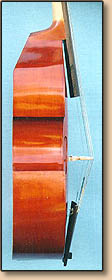The "viola da gamba" is an older bowed instrument than the violin, and was developed during the middle ages, and achieved its final form in the fifteenth century.
The instruments had their origin in the Spanish vihuela, a six-stringed guitar. Since the instrument was held between the knees, its name was the viola da gamba (gamba = the Italian word for thigh or leg). The instrument has frets on its fingerboard, reminding one of its origins. It has 6 or 7 strings, tuned from the outside in fourths, with an interval of a major third at the centre. The violin has tuning in fifths. The bridge is slightly curved, which assists the playing of chords.
The form and thickness of the belly are different from the violin. The back is reinforced by internal ribs. The belly is smaller in its upper bouts, and the back is even (c.f. the double bass). The sound holes are usually C-shaped, and the neck may end in an animal or human head, instead of a scroll.
Various sizes of instrument have been made, and the viola da gamba instruments have formed their own family, just like the violin. The sound of the instrument is smaller and more delicate than that of the violin. In playing, the instrument is held in a vertical position on the knees or held between them.
The instruments of the viola da gamba family vary in size from a treble to a double bass, and these are played both as solo instruments, in accompaniment and in gamba ensembles. The Renaissance and baroque violin family competed with the gamba family for favour. During the baroque period the instruments of both families might play together in the same orchestra. The apogee of gamba playing was the mid-seventeenth century in England. In Italy and later throughout Europe, the violin gradually replaced the gamba, due to its stronger voice.
Types of gamba:
The pardessus gamba is the smallest gamba. It has five or six strings, and is the highest in pitch. Its body is slightly smaller than that of the violin, having a length of about 300-330 mm.
Tuning system:
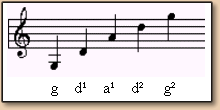
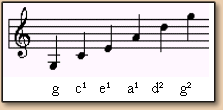
The treble gamba is the next. It is usually six-stringed, and the length of the body is between that of the violin and the viola, at about 335-390 mm.
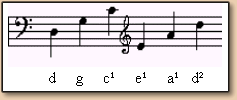
The alto gamba is six-stringed, and slightly larger than the viola. The length of its body is about 430-450 mm.

The tenor gamba is noticeably larger than the viola, but a little smaller than a cello. The length of the body is about 480-550 mm. It has six strings.

The bass gamba is equivalent in size to the cello, with a body length of 620-720 mm. There are six or seven strings. The seventh string is tuned to the pitch A1.
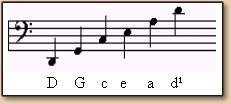
The contrabass gamba is the largest instrument of the gamba family, with a body length of about 1000 mm, or slightly smaller than the double bass of the violin family. The tuning of the six-string contrabass gamba is an octave lower than that of the bass gamba.
Other relatives of the viola da gamba:
The viola bastarda is a bass violin which was used in the English baroque, and which has ornamented soundholes, or rosettes in the centre of the belly. The instrument may also have resonant (or "sympathetic") strings.
The baryton is a close relative of the viola bastarda. It has resonant strings beneath the fingerboard, which may be plucked using the thumb of the left hand. The metallic resonant strings may be 10-40 in number.
The viola d'amore (violin of love) is also equipped with resonant strings. It has no frets. The instrument is placed under the chin, using a normal violin-like position. It was played commonly in the eighteenth century.
The hardangerfele, known as the Norwegian national instrument, is also a relative of the viola d'amore, with four strings for melody, and additional resonant strings.
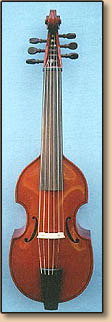
Viola da gamba
(tenor), made by
Jussi Laasanen, 1990
